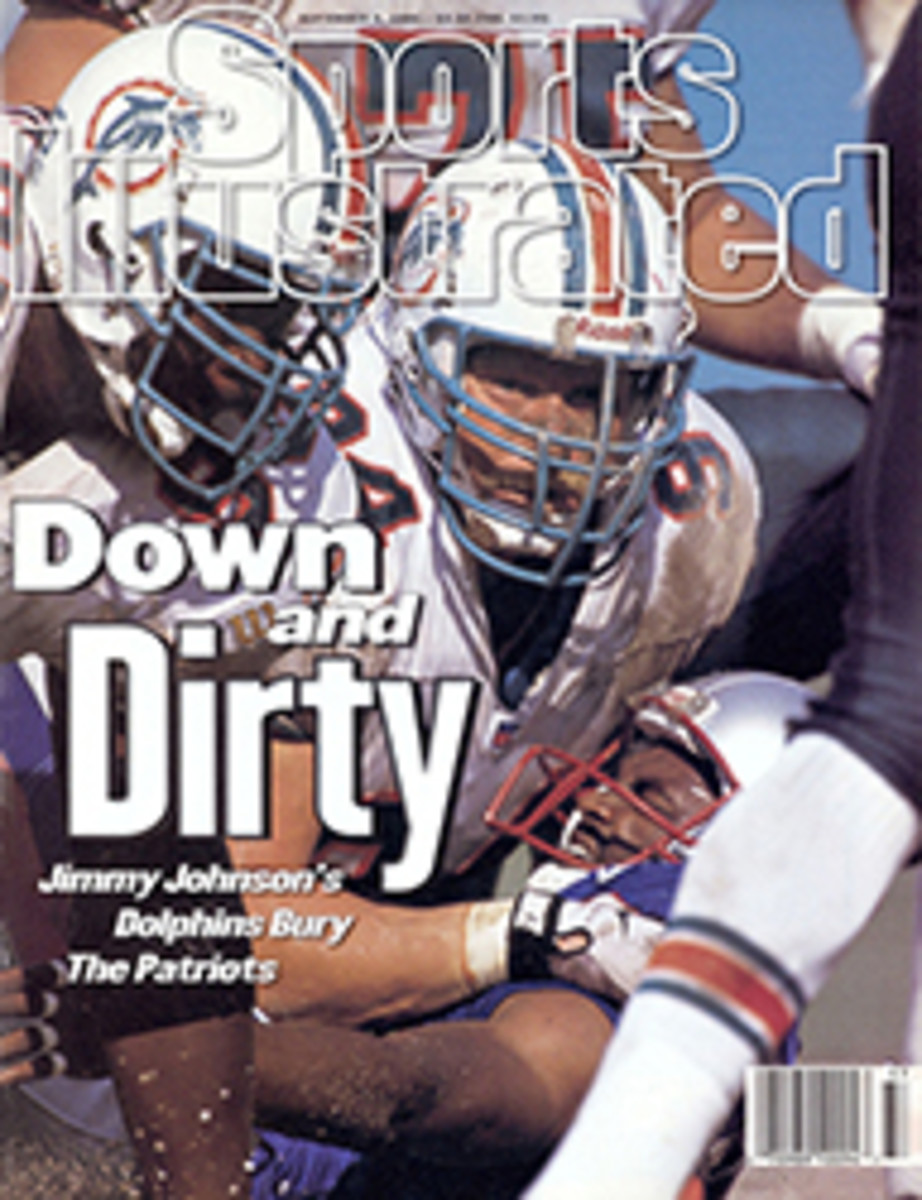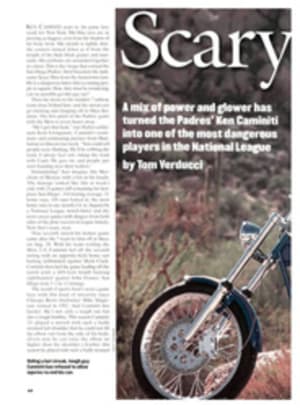
MOLITOR IS A HALL OF FAMER NO MATTER HOW MANY HITS HE GETS AS A DH PIRATES' SURRENDER BOSTON'S IMPOSSIBLE DREAM
NO ASTERISK NECESSARY
If he continues at his current pace, 40-year-old Paul Molitor of
the Twins will bang out the 211th hit of his remarkable season
later this month, giving him 3,000 hits for his career--a total
that has always guaranteed entry into the Hall of Fame. When
Molitor becomes eligible for the Hall, there should be no
argument against his enshrinement at Cooperstown, but there will
be. That's because at week's end 1,148 of his hits had come
while he was a designated hitter (chart, right), a role that
might have allowed him to extend an injury-plagued career for
many years.
Molitor says he expects some purists among Hall of Fame voters
to place a mental asterisk next to his numbers because he has
played so many games at DH. "I'll understand it more than it
will bother me," says Molitor, who through Sunday was leading
the American League with 193 hits and was batting .343, fourth
best in the league. "Probably more than any player in the last
20 years, I have reaped benefits from the DH rule."
One of those benefits is that he has a chance to become the
oldest man to lead the American League in hits. (That
distinction belongs to the White Sox' Minnie Minoso, who had 184
hits at age 37 in 1960.) He could also end up with the highest
average ever by a player 40 or older--now only Ty Cobb, who hit
.357 for the Philadelphia A's in '27, and Sam Rice, who batted
.349 for the Washington Senators in '30, are ahead of him.
Early in his career Molitor spent almost as much time on the
disabled list as he did on the field. He missed 492 games
primarily because of injuries--the equivalent of more than three
full seasons--in his first 10 years in the majors. Since then,
thanks to the DH rule in the American League, he has gone from
injury prone to injury free, or "from tin man to iron man," as
he puts it. He has played 716 games at DH and 139 in the field
in the last six years, mostly because his managers have not
wanted to risk an injury that would keep him out of the lineup.
For instance, Molitor says he could have played first base a lot
more than he did when he was with the Toronto Blue Jays from
1993 to '95, but manager Cito Gaston didn't want to chance it.
Molitor isn't defensive about being a DH, but he does point out
that he's the opposite of the stereotypical big, slow, slugging
designated hitter who couldn't play a position very well.
Molitor, who has 481 career stolen bases, started out as a
shortstop in 1978, then moved to second base, centerfield, third
base, back to second, back to center and finally to first.
"Maybe I incurred some injuries because I played so many
positions," he says. "You know, learning a new position, the
change in throws. I wasn't a Gold Glover, but I was decent
defensively."
If Molitor's numbers are to be challenged because he spent so
much time as a DH, then the stats of several Hall of Famers
should be challenged, too. Reggie Jackson was a first-ballot
inductee mostly because of his 563 career homers. But take away
the stats from his 2,198 at bats as a DH and he had 462 homers,
2,084 hits (not 2,584) and 1,374 RBIs (not 1,702). He still
might have gotten into the Hall, but it would have been a closer
call. Without his at bats as a DH, George Brett--a certain
first-ballot Hall of Famer in 1999--would have had 2,615 hits,
not 3,154. Dave Winfield, a likely first-ballot inductee in
2001, would have had 2,711 hits (not 3,110), 406 home runs (not
465) and 1,613 RBIs (not 1,833).
The bottom line is this: The DH, like it or not, is a part of
the game. The DH is used everywhere in baseball except the
National League. If there were no DH rule, Molitor would have
played in the field for some team because he has always been a
superb offensive player. Maybe his career numbers wouldn't be as
good, but they would be good enough for Cooperstown. "He's a
great team man, he knows the game, he helps other players, and
he runs the bases as well as anyone," says Gaston. "He's a
superstar no matter how many hits he has as a DH."
THE SINKING SHIP
The Pirates, who have held some devastating fire sales during
the last few years, appear to be in worse shape than ever. While
every other team in baseball is looking for young, talented
lefthanded pitchers, Pittsburgh last week traded Denny Neagle,
who had a 27-14 record the last two years while the Pirates were
48 games under .500, to the Braves for pitcher Jason Schmidt and
two minor leaguers, outfielder Corey Pointer and first baseman
Ron Wright, who had 36 homers while splitting time in Class A
and Double A this season.
Owner Kevin McClatchy, who bought the Pirates in February and
vowed to make them more competitive by increasing the payroll
from $18 million to $21 million, reversed field recently and
told Pittsburgh general manager Cam Bonifay to cut the payroll
back to around $18 million. Bonifay had no choice but to unload
Neagle, the Pirates' most marketable player, and his $2.3
million salary. Bonifay got good value in return, but it might
take until the year 2000 before his acquisitions start to pay
dividends.
In the meantime Pittsburgh is going to be even less competitive,
it will continue to lose money, and it will be lucky to draw 1.5
million fans a season. This isn't so much McClatchy's fault as
it is Major League Baseball's for bending over backward to allow
him to buy the club when it was clear he didn't have the capital
to make it work. (McClatchy put up only $12 million of the $90
million purchase price; the rest came from various private
investors.) Baseball's plan was to save one of the game's
historic franchises by giving McClatchy three years to make
things work in Pittsburgh and, if he couldn't do that, to let
him move the franchise. Less than a year later the team's
prospects look bleaker than ever.
DARNED SOX
Red Sox first baseman Mo Vaughn remembers July 3 well. Boston
was a pathetic 34-47 and 15 games out of first place in the
American League East when the Red Sox held a team meeting. "The
whole first half of the season was like running 100 yards and
fumbling at the goal line," Vaughn says. "I told everybody at
the meeting that the fight is not within ourselves, the fight is
out there. It's a war, and if we're not willing to fight, we'll
get to September 55 games back."
September arrived on Sunday, and Boston was only 6 1/2 games out
of first and a mere 3 1/2 behind the White Sox in the wild-card
race when the day ended. Talk about the impossible dream. The
Red Sox went 34-18 from the All-Star break through Sunday and
were 23-8 in their last 31 games. On Aug. 22 outfielder Troy
O'Leary capped a sweep of the A's, in which Boston won each game
in its last at bat, by hitting a homer off the rightfield foul
pole for a 2-1 victory. "Now we're getting all the breaks,"
says Red Sox catcher Mike Stanley. "The whole team is hitting
the foul pole."
That's a far cry from the club that early in the year, Vaughn
says, was filled with "deadwood and dead attitudes." Not to
mention a lot of designated hitters. With Jose Canseco and Wil
Cordero among the defensive liabilities on the roster, the Red
Sox were trying to outslug teams in every game. But midseason
acquisitions such as Jeff Frye, Lee Tinsley and Darren Bragg
have sharpened the defense, which in turn has allowed the
pitching to improve. In his last four starts through Sunday,
Roger Clemens was the Rocket of old, having allowed one earned
run and struck out 35 in 33 innings. And Tim Wakefield's
knuckleball, after a midseason tutorial from Phil Niekro, was
effective again at times in August, when he won three starts.
It's still difficult to imagine the Red Sox winning the East,
but at least they have a shot at the wild-card spot.
COLOR PHOTO: AL BELLO/ALLSPORT Managers don't play Molitor in the field for fear an injury might cost them his bat. [Paul Molitor batting]
Alltime DH Hit Leaders
1 Hal McRae 1,555
2 Harold Baines* 1,242
3 Don Baylor 1,209
4 Paul Molitor* 1,148
5 Chili Davis* 864

